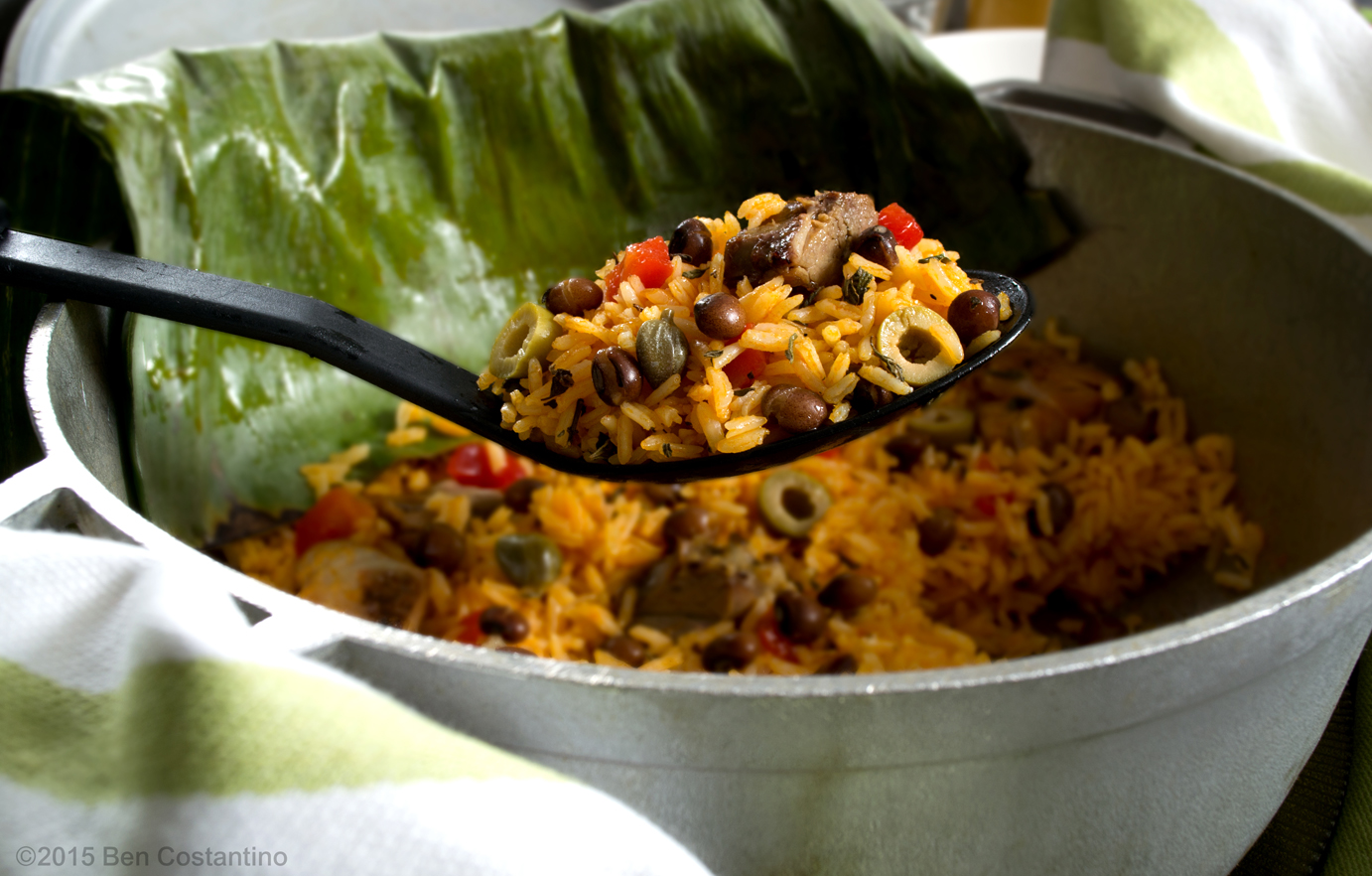
Rice with Pigeon Peas traditionally prepared covered with a banana leaf in an aluminum pot, referred to in Spanish as a “Caldero”.

Pigeon peas (gandules) are a global ingredient, but I first encountered these nutritious legumes in a Puerto Rican context from watching chef Daisy Martinez. This was basically her recipe, until I started doing things differently as I progressed over the years. The global concept of cooking rice and beans in the same pot seems quite simple … seasoning water as best as possible then using that liquid to cook the rice to a fluffy perfection. And depending your dietary preferences, the seasoning can vary from vegetables, meat, bones, aromatics, spices and herbs.
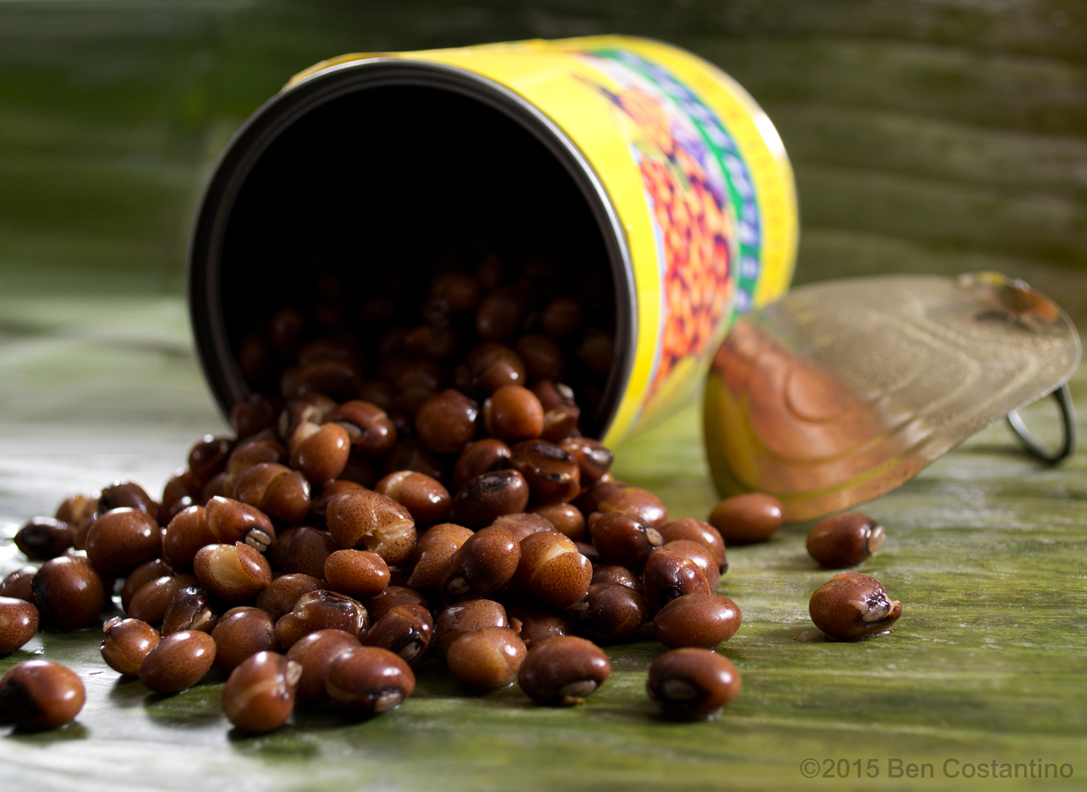
Canned “dry” pigeon peas, I recommed El Jibaríto brand.
Pigeon peas are originally a green color when harvested and are sometimes cooked in its green state. Then they turn brown once they are dried. You can find dried gandules in bags (gandules secos) and hydrate them like any other bean (1/2 pound dry beans = 3 cups hydrated), or buy the canned version (pictured below) that comes in water. The canned beans are obviously not technically dried but they’re still called “dried”. In a pinch, I certainly recommend using the canned version which turns to a brown color and more meaty, filling texture.
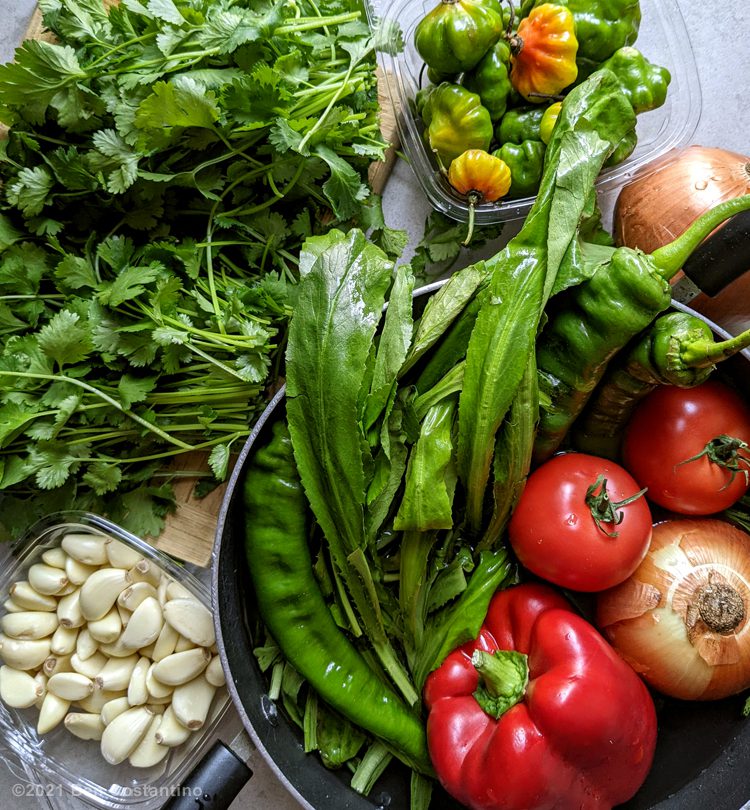
Ingredients for Puerto Rican Sofrito … cilantro, culantro, garlic, Ajicito Dulce peppers, Spanish onion, tomato, red bell pepper, and long Italian pepper. See finished sofrito below.
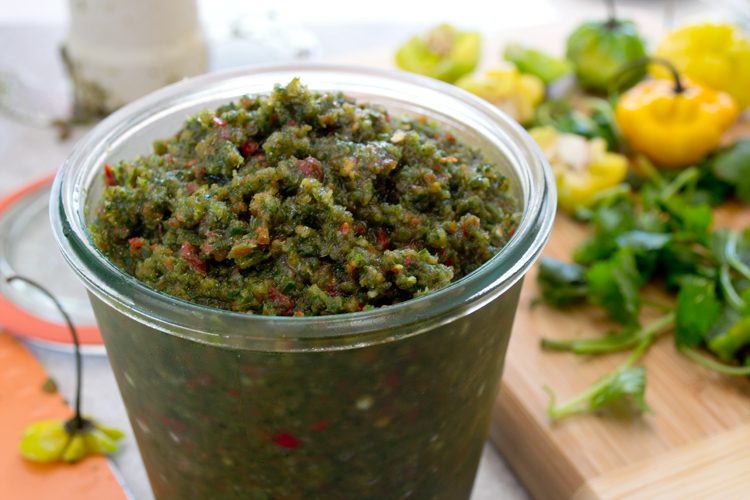
Puerto Rican Sofrito finished and ready to be used as a cooking base.
Puerto Rican Sofrito is an essential base flavor for this recipe. You can’t really make a proper Rice with Pigeon Peas without SOME form of sofrito. While there are lots of ingredients and it’s challenging to find them all in grocery stores, at least try to make something similar to get as close as possible. Culantro and Ajicito Dulce peppers are the two key ingredients that contribute exceptional character, but they’re unfortunately also the two that are most obscure and usually omitted.
Making Achiote Oil
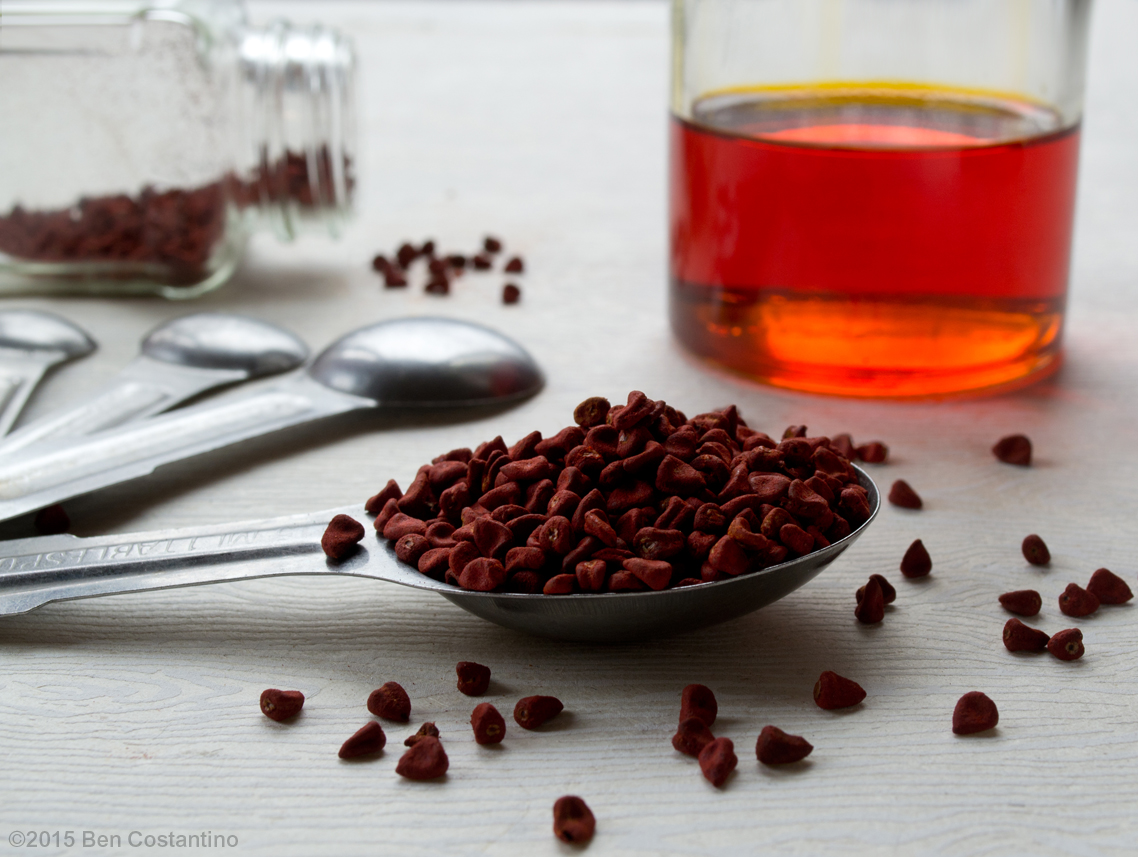
![]()
Ingredients for achiote oil
- 1 cup olive oil
- 2 tablespoons achiote seeds
![]()
Instructions for achiote oil
- In a small sauce pan, combine achiote and olive oil.
- Heat over medium until seeds just begin to sizzle gently for about 30 seconds. No need to stir, just swirl the oil a bit. Do not overheat to the point where seeds begin to turn black. It that starts to happen, move to step 3 immediately.
- Carefully pour not oil and seeds over a small strainer into a ceramic mug and discard seeds. Store unrefrigerated in a sealed jar for up to 2 weeks.
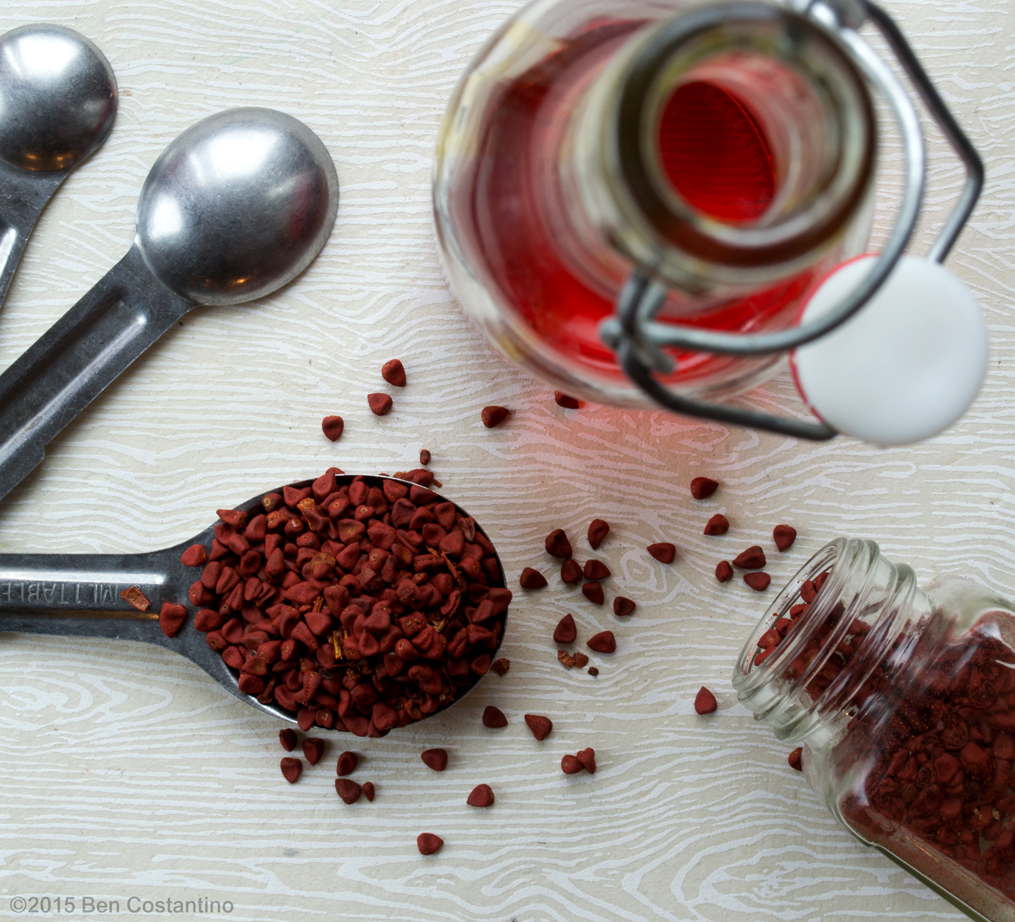
 Rice with Pigeon Peas
Rice with Pigeon Peas

This is a long procedure. The concept of this is to make a broth over the course of 2 hours with meat, herbs and aromatics, then cook the pigeon peas and rice in that highly seasoned liquid. You can speed up the process simply by using store-bought chicken broth and any pre-cooked meat of your choice.
![]()
Ingredients
- 1/2 pound raw bone-in pork shoulder or one large smoked turkey leg (or wing)
- 1 large Spanish onion, peeled and cut in half vertically (pole to pole) but kept intact
- 1 bunch culantro, tied with kitchen twine
- 1 bay leaf
- 1 teaspoon ground black pepper
- 8 inch square of banana leaf (optional)
- 1 cup canned pigeon peas (previously shown above) or 1/3 cup dry pigeon peas, soaked and hydrated
- 2 tablespoons achiote oil (instructions in post above)
- 1/3 cup sofrito (If stored in your freezer, simply break it up into smaller pieces, or defrost it in our microwave at 50% power for 60 seconds.)
- 1/3 cup loosely chopped Alcaparrado (mixture of green olives, capers and pimento)
- 1 cup long grain rice, rinsed
- 1 teaspoon kosher salt
- 4 ounces plain tomato sauce
- 1 tablespoon crushed Dominican oregano
![]()
Instructions
- Place the meat, Spanish onion, cilantro, bay leaf in a large wide pot and cover with 5 cups of water. Bring to a brief boil then reduce to a simmer. Cover contents with banana leaf (for added flavor) and simmer until the meat falls off the bone, about 2 hours. Add the pigeon peas after the first 1 1/2 hours and simmer them in the broth for the final 30 minutes.
- After 2 hours you should have slightly more than 2 cups of liquid. Discard any bones, pork or turkey skin, cooked onion halves, culantro and bay leaf. Break apart 1/2 cup of meat into thumb-sized pieces and save the rest for later use. To briefly measure liquid, pour contents through a mesh strainer over a bowl and reserve slightly less than 2 cups (1 3/4 cup is too little but 2 cups is too much). Re-combine measured liquid, meat and beans. Return measured broth, pigeon peas and meat to pot and set aside. Save any extra broth for later use.
- In a separate wide bottomed aluminum pot, heat achiote oil over medium flame. Sauté sofrito, meat and alcaparrado until sofrito begins to caramelize slightly and smells fragrant, stirring occasionally. Ingredients should sizzle immediately when dropped in the oil.
- Add rice and salt then stir throughly until grains are evenly coated with oil. Allow rice to cook until in oil for about a minute, then increase heat to high. It will appear dry but no need to worry, liquid is coming.
- While maintaining high heat, add your reserved measured broth mixture (with pigeon peas, and meat) tomato sauce and Dominican oregano and stir until evenly combined, breaking up any carmelized bits of sofrito fond and rice stuck on the bottom of the pot. This is a good time to test the liquid and adjust flavor with salt or pepper. Bring to a vigorous boil.
- Continue boiling and do not stir the rice until the liquid level cooks down to meet the level of the rice. Once the level is equal, gently agitate the rice with one (maybe two at the most) gentle stir only to release any rice stuck to the bottom of the pot. Too much stirring will result in a gummy texture.
- Reduce heat to low, cover with lid and simmer for 20 minutes. Leave it alone for the entire time, do not stir or even open the lid to “check” on it.
- After 20 minutes turn off the heat, briefly remove the lid and gently lift the cooked rice from the bottom to the top a few times. Let it rest for another 20 minutes with the lid on before serving.
Yield: 4 to 6 servings as a side dish, about 5 cups

